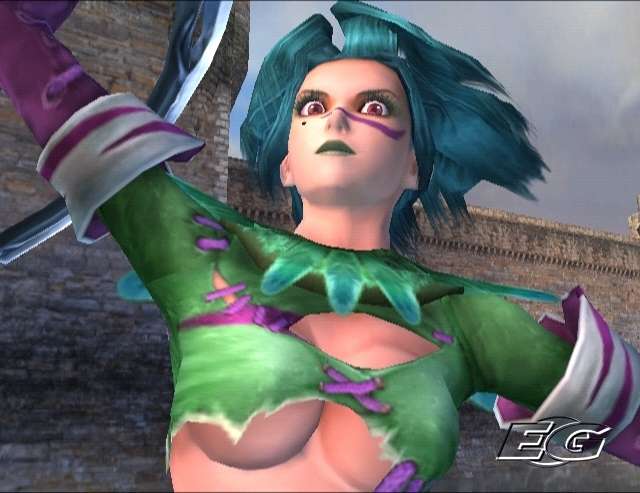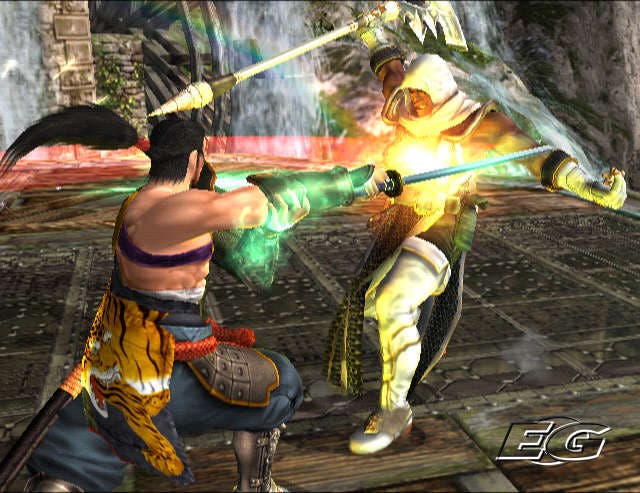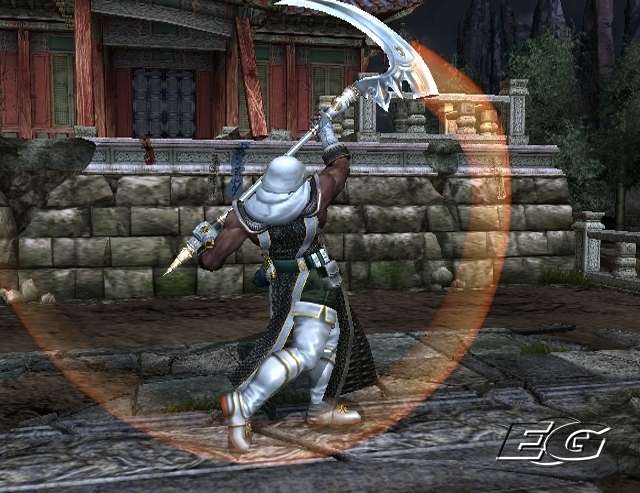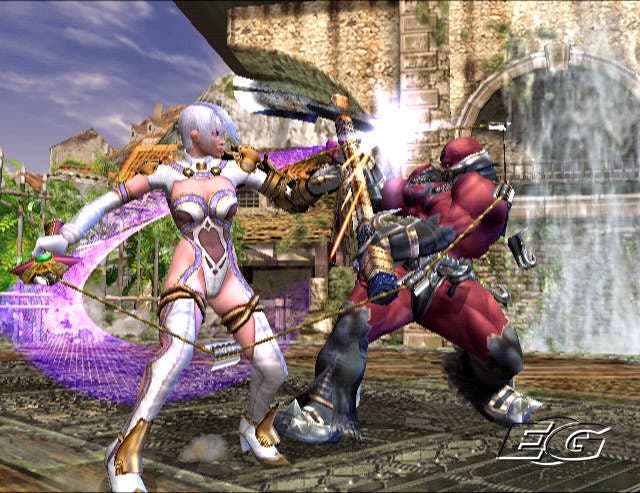SoulCalibur III review
Still burning.
For many of us, the SoulCalibur series represents the pinnacle of beat-'em-ups. Residing in a satisfying niche between depth and accessibility, it's one of the few examples in the often wilfully hardcore genre that doesn't require a daunting level of expertise to enjoy. Namco seems to go further with every incarnation to reward the fans with a bewildering amount of extra content, new characters and modes, yet still delivers a game that even newcomers to the scene can get straight into. In almost every sense, version three of this fantastic series continues this fine tradition.
Given the universal acclaim of 2003's revered sequel, the only thing left for Namco to do was take the series online. In many ways, that was the only important element missing from the package, yet Namco has curiously decided to spurn that golden opportunity with version three, choosing, instead, to beef up the single-player content in ways that not everyone has been particularly receptive to.
Even more bizarrely, the multiformat approach brought in with SoulCalibur 2 has been axed, with Sony presumably passing a large money hat to its Japanese friends to ensure PS2 exclusivity this time around. And with no arcade version either, this is the only opportunity fans will get to sample the latest evolution of the classic series.
Ian Botham

As you might expect for a sequel following just two years on from the last version, the changes won't seem exactly radical to the casual observer, with just three new characters to bulk up the already fairly beefy roster of around 30 (around half of which remain tightly locked away from the beginning). But dig a little deeper, and there's easily enough new content and tweaks to the existing character set to keep even hardcore devotees busy for weeks
Typically, the game's central story mode 'Tales of Souls' is a basic series of single-round matches against various opponents, each featuring the usual overblown super-serious storyline that actually makes very little sense at all, and does nothing to justify why, exactly, you're beating the crap out of some stranger with a scythe. To vary your path, there's a sort of throwaway attempt at introducing a 'choose your own adventure' aspect to the proceedings, enabling you - on occasion - to face off against a series of tough opponents in quick succession, with an unlockable dished out as a reward for success. Regardless of your character choice, though, the scenarios and settings appear to be largely identical, and your choices actually make little difference to the outcome, so in a sense the only 'point' of this mode is to gain much-needed practise, and to unlock other new characters along the way. With fairly lengthy load times and the slog that goes with playing through the same sections multiple times, it's perhaps not the most entertaining way of spending time with SoulCalibur III, but certainly serves as the best introduction.
As previously, the fighting system is simple yet structured in such a way as to give enormous depth of possibilities to any given scenario. Using the four main face buttons and the left stick, you're given the choice of horizontal and vertical slashes, kick and block, but beyond that there's eight directions of each, combinations and time-specific variations that make it an exceptionally fluid system that works just as well as it ever did. On a basic level nothing much has changed; it's still the attack-oriented game it always was, but then that's just as well. Advanced players will be the ones playing spot the difference, with certain characters' move-sets rejigged in subtle and no-so-subtle ways. Previously similar characters feel more distinct, yet on the whole SoulCalibur 3 still feels like a game that anyone can get into and take time to master.
Rock, paper, scissors

Joyously, it's not a game that button-mashers will prosper in. With much of the fun coming from anticipating retaliation and taking advantage of downed opponents, there's an answer to many of the seemingly devastating moves. Deflecting attacks, being nimble and mixing up high and low attacks is just as important as knowing the complex combos - especially against someone who knows what they're doing. The game's also consistent in its design, with basic move-sets available across all the characters, making it easy to seamlessly change from one to the other without feeling overly hamstrung.
The addition of a seemingly endless array of new weapons adds a further layer of subtlety, experimentation and mastery to the proceedings, and although there's arguably such a thing as too much choice, the constant array of new unlockables helps keep the game feeling fresh long after the initial novelty has worn off. On the other hand, Namco has still recycled much of what went before with relatively minor technical enhancements, so don't expect sweeping changes: this is very much an evolution of an already excellent game.
In terms of the trio of new fighters, they're all evil and eye-catching in equal measures; first up is the parasol-waving Geisha, Setsuka, full of blade spinning rage, then there's the scythe-wielding warrior Zasalamel (a great choice for beginners with his long reach), while the razor sharp hoop-wielding Tira certainly makes for an eye-catching new entrant with an impossibly evil weapon that Tarantino himself would be proud to emulate. Tellingly, you'll probably find yourself returning back to the old favourites and sussing out what's changed, but that's no great shock.
Put to the sword

The new 'Chronicles of the Sword' mode, meanwhile, lends a greater sense of purpose to the relentless bouts, and works hand-in-hand with the new character-creation mode. Presenting you with a few core character classes (male or female), the chance to create your own truly distinct warrior is actually much more restrictive than we would have expected, limiting the actual look of your creation to a bewildering number of outfits rather than physical attributes. Although you can conjure some hilarious freaks from the massive amount of options available, what you end up with is costume variations based purely on a standard model. For example, you can't tweak the height, weight or build, and must instead sort through few stock face types and haircuts. Over the course of the game you do, admittedly, unlock a stack of new items, but compared to the flexibility of other create-a-player systems in other titles, this doesn't allow you to do much more than dress them up - and with no ability to use your creation outside of this mode, it's even more of a missed opportunity.
The pseudo-strategy-based Chronicles of the Sword, meanwhile, is much more absorbing than some have given it credit for once you progress into the more challenging segments beyond the rather tiresomely basic opening chapters. The general idea is to capture the main base on each map, and to do so requires winning bouts with a variety of generic grunts and the occasional 'known' character from the main game. But rather than making you slog through it alone, gradually more slots in your character roster open up, allowing you to either create new characters or utilise the hired hands that join you, RPG-style.
With each character comprised of four main stats and an overall level, you gain experience every time you fight - win or lose - with points gained from each bout gradually helping you rank up and become a better, more capable fighter. Needless to say, anyone into RPGs or hackandslashers will find themselves gradually drawn into the whole business of building up their party of fighters, and relish the opportunity to spend their hard-earned gold on all manner of weaponry, armour and miscellaneous tat - some of which allows you to swap your arsenal before a sortie, and potentially become a totally different type of fighter along the way.
Real time beat 'em up strategy

When you get down to business, you guide little icon representations of each individual fighter around the isometric map, getting them to bash down fortresses and take on the opponents inside. If there's a few of them inside, you might decide to go in mob-handed, giving you a better chance of finishing them off if one of your fighters gets knocked out. But even when you do lose a bout, as long as one of your party remains alive, the others 'retire' back to your HQ and eventually rejoin the battle when they're fit and able. With this slightly curious mechanic of allowing you to regain beaten units, you can rotate your active fighters and slowly chip away at each fortress, clear out the occupants and make a beeline for their main base. On the other hand, if you lose all your fighters or have your own HQ captured, then you fail the mission and have to start over.
Combining SoulCalibur's fighting excellence with the obsessive nature of RPG nurturing and strategic unit positioning will either strike you as a pointless slog or maddeningly compulsive, depending on your preferences, but it kept us going for more hours than we'd care to admit. Once you've levelled up significantly (say, level 30) and have four or five fighters to point around the map, a genuine degree of strategy comes into play, especially when enemy units start aggressively charging towards your base in numbers that make it exceptionally tough to fend off. Admittedly the map presentation's a tad rudimentary, the loading times are a leeetle slow, and the storyline that accompanies the whole affair is completely throwaway, but since when did such trifling matters ever put off a SoulCalibur fan?
With so many weapons, assorted items and even characters unlocked as a result of playing through all 20 chapters, there's a pretty big incentive for sticking with it, even if it does seem a little pointless in the beginning. In terms of providing a solid single player context, Chronicles of the Sword provides a far most lasting challenge than any of the other solo modes on offer.
Soulless

Elsewhere, SoulCalibur III even offers up a bunch of throwaway novelty 'Soul Arena' challenges, with around ten specific mission objectives (over three difficulty levels) such as collecting coins, fighting on a spinning turntable or throwing your opponent against the wall. Meanwhile, the practice mode helps give essential advice on the assortment of moves in the game, while a World Competition mode offers up one-off tournaments or leagues if the other solo modes weren't enough (though, annoyingly, you can't actually save your progress). There's support for up to eight players in World Competition as well, but it serves as a rueful reminder of how online play could have so easily complemented things. Maybe next time?
As a package, it's interesting how much effort Namco has put into making sure SoulCalibur III provides a huge amount of single-player content. On that level, you couldn't really ask for more. As one colleague put it recently, it really is the pinnacle of the genre in terms of giving you loads of stuff to do in the game and a constant sense of achievement. It's rare to come away from a single bout not having unlocked something, be it an item of clothing, or an alternate weapon to try out elsewhere, or maybe Tom's favourite - endless concept art. Quite how long you'd have to play the game to exhaust all the possibilities is impossible to say, but when you realise that certain conditions for unlockables is to play 1,000 bouts, it's a game designed for the long haul.
For those of you that have always bought into the series for the Versus matches, some of the character balance changes may irk. Although it's hard to think of anything but good things to say about the single player experience, in two player bouts the niggles may start to worm their way in and make you wish for the way things used to be. Previously balanced characters like Mitsurugi have been meddled with, perhaps in an attempt to make powerful moves more easily accessible to novices, while others who were already arguably "cheap", such as Kilik, have been inexplicably made even faster and more powerful. We shouldn't overstate the seriousness of this problem; the majority of players, especially newcomers to the series, probably won't spot this unless they sink hours into learning the game. However, it's a tad frustrating for those of us who've wasted our precious youth on previous versions; many people buy beat 'em ups to play with a group of hyper-competitive friends, and it's worth warning you that you may find a small number of the characters breaking the sense of competition such a game should foster. At least have ready made excuses handy, anyway.
Bead-em-up

It hardly needs re-iterating that from a visual aspect, Namco has again done a fantastic job on the whole of delivering wonderfully detailed (and varied) characters, all animated exquisitely (in full, slick 60 frames per second) and sporting some of the most bone-crunchingly satisfying manoeuvres any beat 'em up has attempted. The backdrops don't quite match up with the DOAs of this world in terms of the multi-level wow factor or their stupendous destructibility, but sport so much incidental backdrop detail that - in real terms - it hardly matters. You'll be too busy concentrating on the excellent fluidity of the combat to spend more than a split second casting your eyes elsewhere, and that's ultimately what counts.
The audio, though, is as typically hammy as it's ever been, with comically overblown voiceovers deadpanning some of the most pointlessly elaborate excuses as to why a scantily clad lady is about to take a giant spinning blade to the face of a passing warrior who just happens to be wielding the biggest axe ever made. All in a day's work, we suppose. Musically, Namco presses the button marked 'dramatic and flighty' with aplomb. We salute you.
After such a lengthy hand-wringing exercise, we're back where we started. SoulCalibur 3 is easily one of the most joyous examples of how to make an instantly appealing beat 'em up that's intuitive to pick up and play, yet deep enough to last the distance. The beefed-up single-player content is worth the asking price on its own, it's still a fantastic multiplayer game (that's maybe not as perfectly balanced as it once was), and yes, it's shame there's no online play, but that's no excuse to pass up on a hugely enjoyable, addictive, rewarding title that'll last months.


